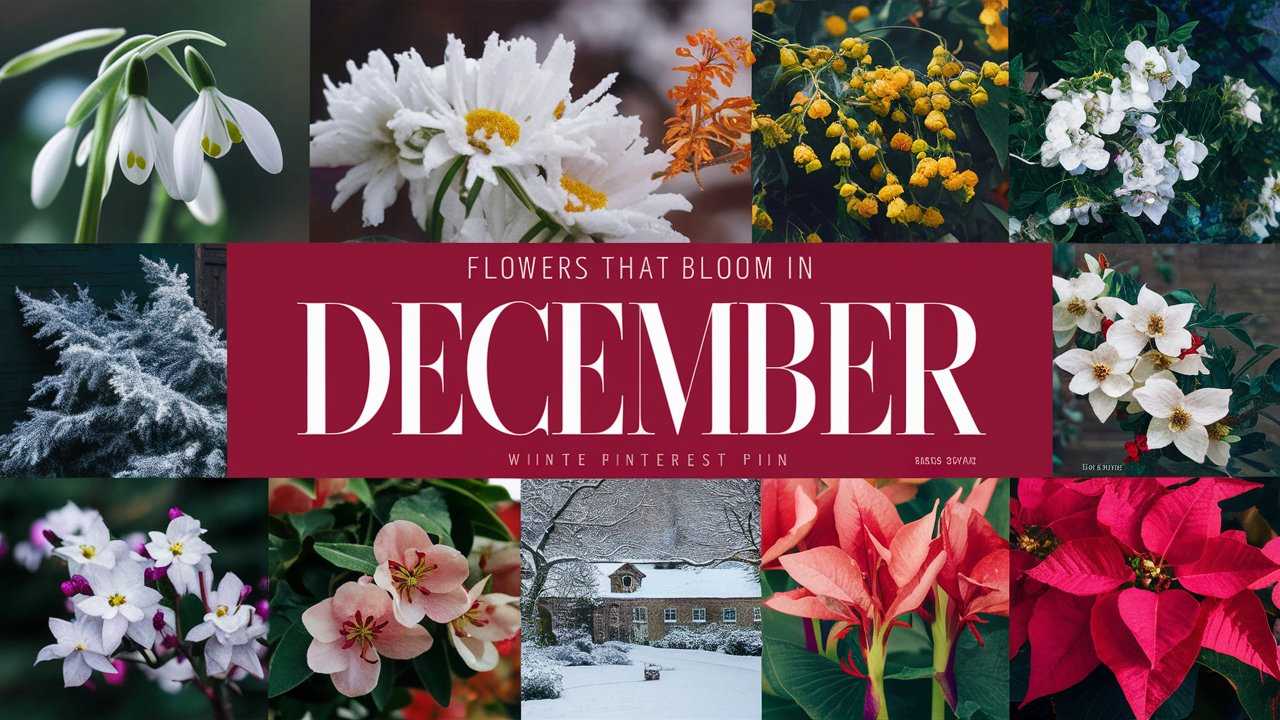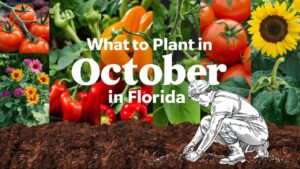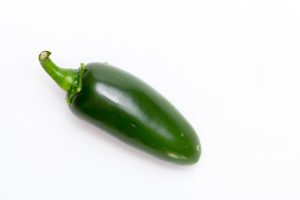As the chill of December envelops the Northern Hemisphere, gardens may appear dormant, yet a collection of resilient blooms springs to life, adorning the frosty landscape. This month, we’ll explore three standout flowers that thrive in December, adding color and charm to the winter season.
Christmas Rose (Helleborus niger)
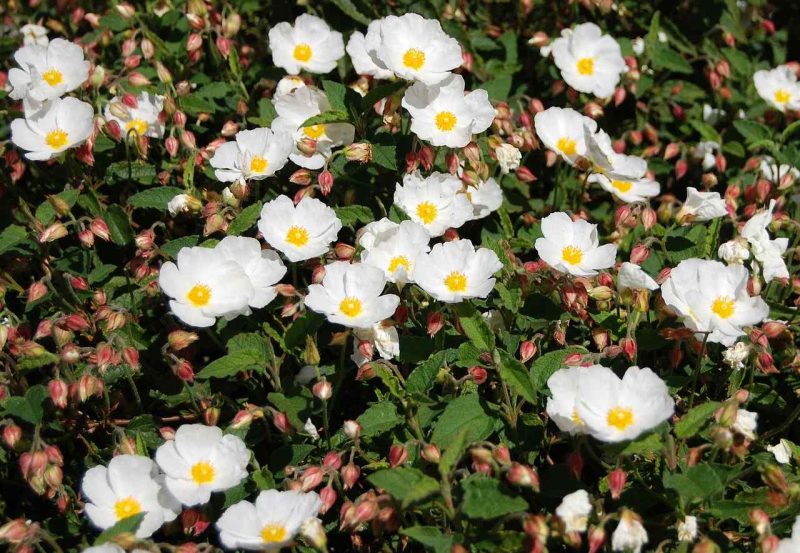
The Christmas Rose, with its elegant white flowers, is often associated with the festive season, thriving in the coldest months. Native to the mountainous regions of Central and Southern Europe, Helleborus niger is renowned for its ability to bloom even when the ground is blanketed in snow. The exquisite blossoms, which can range from pure white to a soft pink hue, typically emerge around Christmastime, hence their evocative name.
What sets this plant apart is its adaptability. The Christmas Rose is a perennial that appreciates a partially shaded environment and well-drained soil. Its evergreen foliage provides visual interest even after the blooms have faded, making it an appealing choice for winter gardens. Additionally, its flowers hold a delicate fragrance that delights the senses, an unexpected surprise during the frost-laden months.
Symbolically, the Christmas Rose is often linked to rebirth and hope, making it a poignant emblem during the holiday season. The legend tells that it sprang from the tears of a young girl who was saddened by the birth of Christ, representing purity and the spirit of giving. Including this charming flower in December arrangements not only enhances the visual appeal but also infuses the mood with an uplifting message.
Primrose
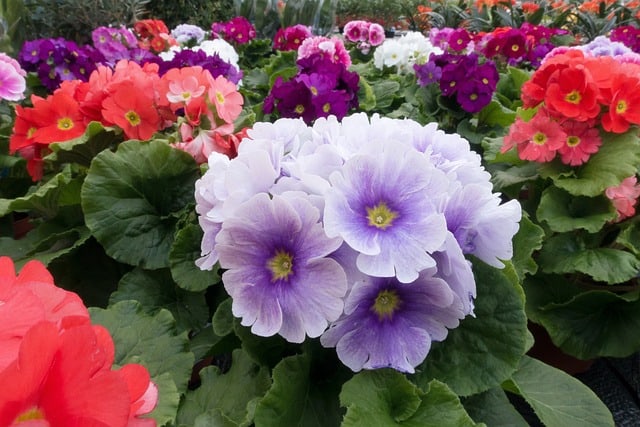
The Primrose, specifically the species Primula vulgaris, is another wonderful flower to consider for December gardens. Its cheerful blooms, available in a plethora of colors including yellow, pink, and blue, bring a splash of brightness to the otherwise subdued winter palette. Primroses are hardy perennials, capable of surviving even the harshest winter conditions, which makes them a popular choice for early winter flowering.
These flowers thrive in rich, moist, and well-draining soil and enjoy a sunny or partially shaded location. Their low-growing habit makes them an excellent option for edging garden beds or as ground cover. In addition to their beauty, Primroses are particularly appealing because they attract early pollinators such as bees, helping to sustain local ecosystems during the colder months when food is scarce for these creatures.
Culturally, Primroses have significant meaning; they are often associated with the return of spring and the end of winter’s harshness. Their ability to bloom in December can symbolize perseverance and the anticipation of brighter days ahead. With their vibrant hues and delightful presence, Primroses can enliven window boxes and festive arrangements alike, maintaining a sense of optimism during the winter chill.
Glory of the Snow (Chionodoxa spp.)
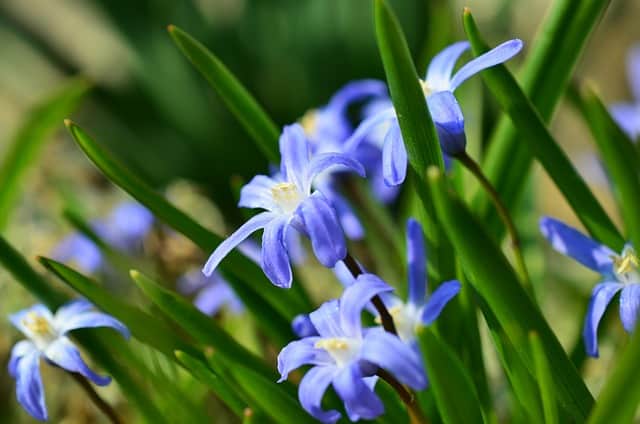
A true herald of spring, yet often mistaken for winter gems, the Glory of the Snow is a delightful flower that brings joy to gardens during December. Native to the mountainous regions of the Eastern Mediterranean, these small, star-shaped blooms are among the first to emerge from the ground, often peeking through the snow. The most common variety, Chionodoxa forbesii, showcases lovely violet-blue flowers that can light up any garden with their vibrant color.
Glory of the Snow prefers well-drained soil and does best in full sun to partial shade, making it a versatile choice for rock gardens or naturalized areas. This plant is not only tolerant of cold temperatures but also thrives in them. Once established, Glory of the Snow spreads gracefully, creating lovely patches that add a dazzling touch to winter landscapes.
In terms of symbolism, the Glory of the Snow represents renewal and the promise of new beginnings. Its early blooms serve as a reminder that spring is just around the corner, offering hope and joy amidst the winter’s grip. These petite flowers, with their star-like shapes, evoke feelings of wonder and appreciation for the beauty that can emerge even in the darkest and coldest months.
Pansies
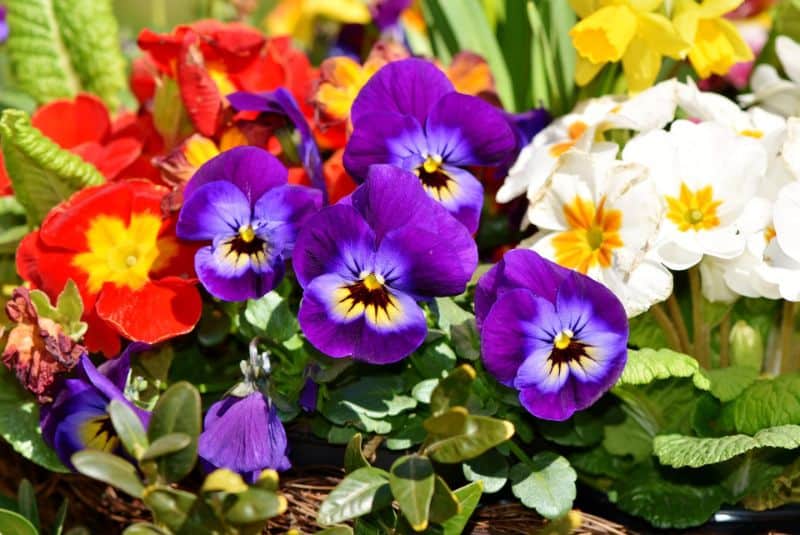
Pansies are a beloved staple in winter gardens, known for their cheerful, vibrant blooms and heartwarming variety of colors. Botanically classified as Viola tricolor var. hortensis, these hardy annuals can withstand chilly temperatures, making them perfect for December displays. Their broad, flat flowers resemble smiling faces, which often leads to their common nickname, “faces in the garden.”
What sets pansies apart is their remarkable adaptability. They thrive in a range of environments, from window boxes to garden beds, and they can bloom under various conditions. With proper care, including consistent watering and fertilization, pansies can produce flowers from fall until early spring, providing long-lasting color during a season often devoid of blooms.
Culturally, pansies have a rich history and symbolism. In the language of flowers, they represent remembrance and loving thoughts. This connection to nostalgia makes them a popular choice for holiday arrangements, whether used in pots or as ornamental accents in home decor. Adding pansies to your winter garden not only brings joy but also evokes tender memories and connections with loved ones, enriching the emotional landscape of your outdoor space.
Snowdrops
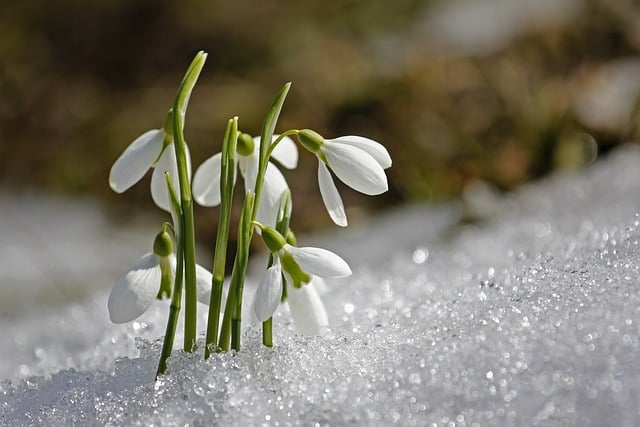
Snowdrops (Galanthus nivalis) are iconic harbingers of hope during the winter months. Even though they typically bloom in January or February, their presence in December gardens is increasingly recognized, particularly in more temperate climates. With their delicate white, nodding flowers, snowdrops often emerge from the ground while snowflakes decorate the landscape, serving as a poignant reminder of nature’s persistence in even the harshest conditions.
These perennial bulbs thrive in well-draining soil and prefer partially shaded areas, making them ideal for woodland gardens or the edges of beds. Once planted, snowdrops will multiply over the years, creating naturalized clusters that lend a touch of ethereal beauty to winter settings. Their unique adaptation enables them to push through the frozen ground, symbolizing resilience and purity amid winter’s chill.
In folklore, snowdrops represent rebirth and the promise of new life, often viewed as a signal that spring is on the horizon. Their delicate beauty and ability to flourish even in adversity serve as inspiration, reminding us of the hope and renewal that accompany the new year. Incorporating snowdrops into your December landscape not only highlights their enchanting presence but also evokes feelings of optimism as winter begins to wane.
Winter-Flowering Clematis

The Winter-Flowering Clematis, particularly Clematis cirrhosa, is a unique choice for December blooms. This evergreen climber stands out with its charming, bell-shaped flowers, often found in creamy white or pale yellow, and they can provide an unexpected touch of elegance during the winter months. Flowering from late fall through early spring, this clematis variety is a true gem that offers visual interest when most other plants are in dormancy.
Winter-Flowering Clematis thrives best in well-drained soil and prefers a sunny location, although it is tolerant of partial shade. Its vigorous growth habit makes it an excellent choice for trellises, arbors, or fencing, lending beauty to vertical spaces while also creating habitat for beneficial wildlife. Beyond its flowers, the foliage of this plant remains lush throughout winter, ensuring that gardens have evergreen interest even in the cold.
Symbolically, clematis is associated with ingenuity and creativity due to its ability to thrive in challenging conditions and its many forms. Including Winter-Flowering Clematis in your December garden offers not just aesthetic pleasure, but also a representation of perseverance and the capacity to adapt in the face of adversity. This flower serves as a vibrant testament to the beauty that can flourish, even in the coldest days of the year.
Winter-Flowering Shrubs and Trees
Winter-flowering shrubs and trees are a fantastic addition to any garden, showcasing textures and colors that stand out against the typically stark backdrop of winter.
Bougainvillea
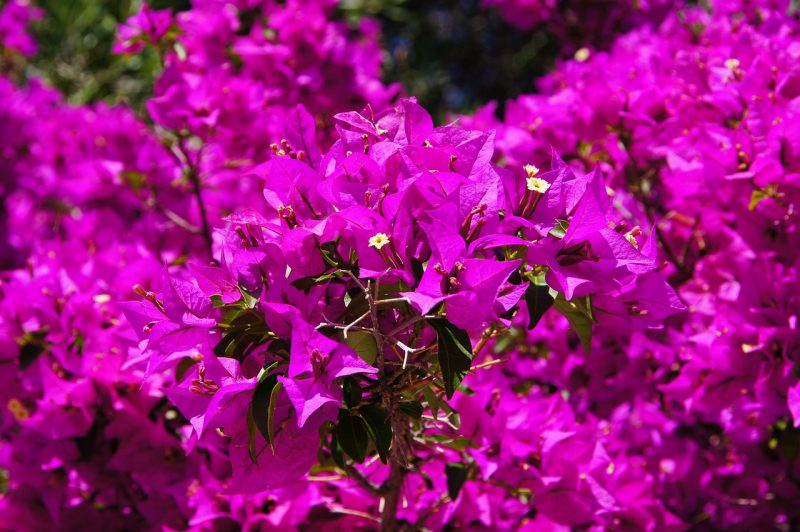
While Bougainvillea is more commonly associated with warm climates and vibrant summer displays, certain hardier varieties can surprisingly thrive through the winter months in milder areas. With their explosive color range and lush foliage, Bougainvillea creates a stunning visual impact in any garden. Their vibrant magenta, purple, red, and orange bracts can brighten up dreary winter days, making them an exotic choice for December gardens.
To ensure that Bougainvillea stands a chance against December’s chill, it is essential to choose frost-resistant varieties and provide adequate protection in colder regions. Planting in well-drained soil and ensuring full sunlight is crucial for ensuring these drought-tolerant plants not only survive but thrive during the cooler months. In southern climates, Bougainvillea can bloom continuously, providing a splash of tropical vibrancy throughout the season.
Symbolically, Bougainvillea represents passion and abundance, making it a fitting choice for celebrating the joy of the holiday season. As these bright and cheery flowers draw the eye and lift the spirits, they can serve as a reminder to embrace the fiery passion within us even during the coldest of months. By incorporating this vibrant plant into your December garden, you introduce an exotic flair that transcends the usual winter landscape.
Fragrant Sweetbox
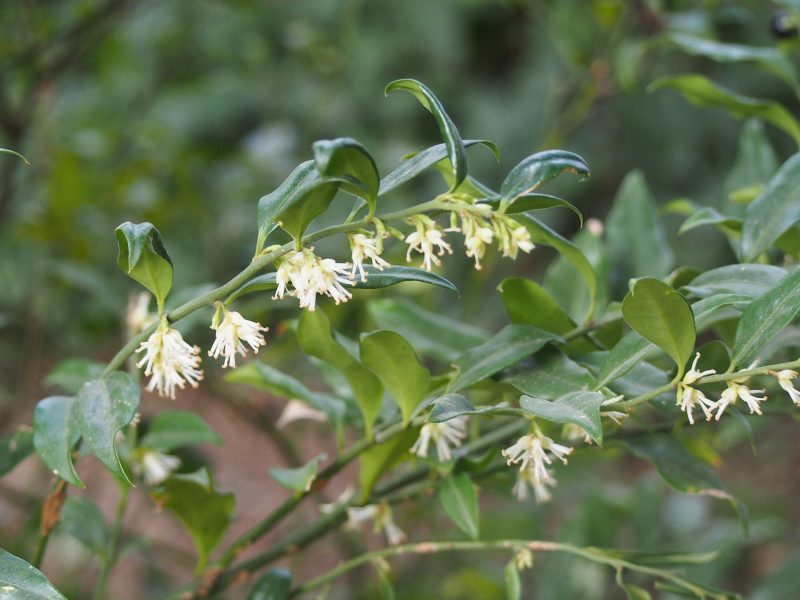
For those seeking an understated yet delightful addition to their December garden, the Fragrant Sweetbox (Sarcococca confusa) is a superb choice. This evergreen shrub produces small, inconspicuous white flowers that pack a powerful fragrance, often likened to that of jasmine or sweet spice. Blooming in late winter, this shrub’s scent wafts gently through the air, providing an early glimpse of spring’s promise, even before the blooms arrive.
Fragrant Sweetbox thrives in shade or partial shade, making it ideal for those tricky, darker areas of the garden. Its preference for rich, well-drained soil allows it to flourish in various garden settings, including borders and shaded woodland regions. As a low-maintenance plant, it requires minimal attention, allowing gardeners to enjoy its beauty and scent without excessive effort.
This fragrant shrub carries deep symbolic value, often representing enduring love and devotion. Its sweet aroma and persistence make it an excellent choice for commemorating cherished relationships during a season that emphasizes connection and warmth. Including Fragrant Sweetbox in your December landscape not only enriches your garden but also speaks to the heart, reminding us of the beauty found in small, subtle moments.
Mahonia
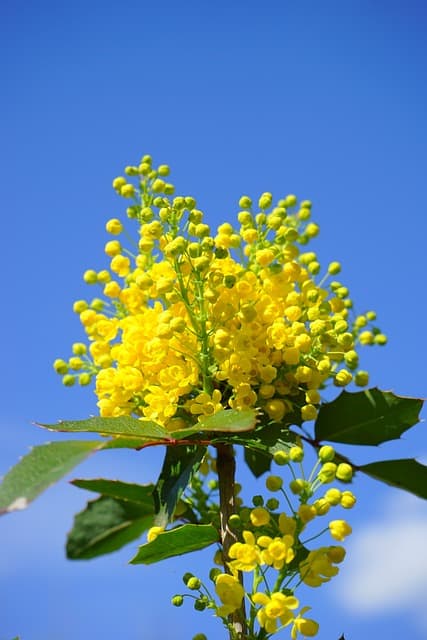
The Mahonia, often referred to as Oregon Grape, is a remarkable evergreen shrub that captivates gardeners during the cold winter months. With its spiny, holly-like leaves and vibrant clusters of yellow flowers, Mahonia (Mahonia aquifolium) offers a stunning display that remains striking even amid frost and snow. The flowers typically bloom from late autumn into winter, creating a bright splash of color that can brighten any dreary day.
Mahonia is incredibly adaptable and thrives in a variety of soil types, though it prefers well-drained, slightly acidic environments. Its preference for partial shade makes it an excellent candidate for underplanting in woodland areas or as a standalone feature in shadier spots. Beyond its aesthetic appeal, Mahonia produces blue-purple berries that are attractive not only to gardeners but also to various bird species, providing essential nourishment during the winter months.
Culturally, Mahonia is often associated with protection and healing, as many of its species have been used in traditional herbal medicine for their potential medicinal properties. Including Mahonia in your December garden not only enhances its charm with its striking blooms but also promotes biodiversity by supporting local wildlife, offering a beautiful reminder of nature’s interconnectivity.
Japanese Pieris

Japanese Pieris (Pieris japonica), also known as andromeda, is a captivating evergreen shrub that thrives in gardens throughout December. Characterized by its glossy leaves and clusters of delicate, urn-shaped white or pink flowers, Japanese Pieris adds an air of refinement to winter landscapes. These blooms emerge in late winter, typically from January to early March, but the attractive foliage and buds are undeniably appealing throughout December.
This shrub thrives in well-drained, acidic soils and prefers part shade to full shade, making it an excellent choice for shaded garden areas, where its glossy leaves can truly shine. Additionally, Japanese Pieris is relatively low-maintenance, requiring minimal pruning and care once established. The combination of its attractive foliage and clusters of flowers offers a multi-season interest, providing a vivid focal point in the garden even before the blooms unfold.
Symbolically, Japanese Pieris represents purity and sincerity, adding a layer of depth to its visual appeal. By planting this elegant shrub in your December landscape, you invite beauty and grace into your garden while contributing to a peaceful and serene atmosphere, reflective of the quiet moments of winter.
Rosehips
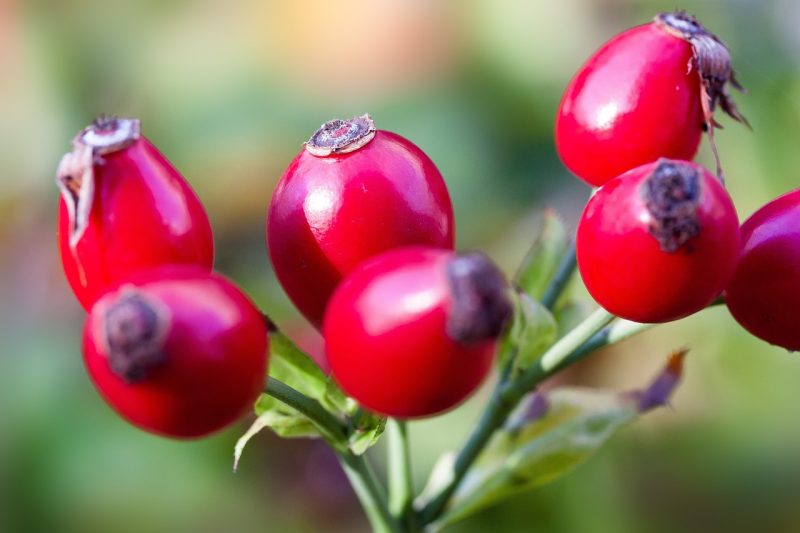
While most flowers may be absent during the December chill, the vibrant fruit of wild roses—the Rosehips—takes center stage. These small, round, typically red or orange fruits form after the garden roses bloom and serve as a wonderful reminder of the season’s bountiful offerings. Rich in vitamins and antioxidants, rosehips have been celebrated for their nutritional benefits and can be used in teas, jams, and herbal remedies, making them a practical addition to any garden.
Rosehips thrive in various soil types, preferring well-draining conditions, and they are often a natural byproduct of growing rose bushes. This hardy plant adapts well to different environments, including sprawling landscapes and urban gardens. While the flowers of roses may fade during December, the striking rosehips add a pop of color and texture, creating visual interest against the barren backdrop of winter.
In folklore, rosehips symbolize hope, vitality, and the idea of renewal, making them a fitting emblem for the end of the year. Including rosehips in your December garden not only enhances its beauty but also serves as a reminder of the resilience that nature embodies. Their brilliant hues attract birds and wildlife, providing essential sustenance during winter when food sources are scarce.
Holly
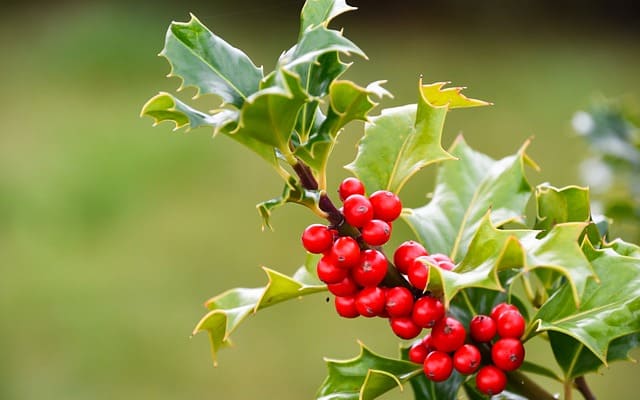
Holly (Ilex aquifolium) is perhaps one of the most recognizable symbols of the holiday season, known for its glossy, spiky leaves and bright red berries. This evergreen shrub flourishes in December, providing a striking contrast against the typically stark winter palette. The vibrant berries are not only beautiful but also play a crucial role in the ecosystem, offering sustenance to various birds during the colder months when food is scarce.
In terms of cultivation, holly thrives in well-drained soil and can tolerate a range of lighting conditions, making it a versatile choice for gardens. It’s important to plant both male and female holly plants if berry production is desired, as only female plants produce those iconic red berries when pollinated. Holly’s ability to retain its foliage and produce fruit year-round makes it a favorite for seasonal decorations, wreaths, and festive arrangements.
Culturally, holly has been associated with protection and good luck for centuries. In ancient Rome, it was used in winter celebrations, while in medieval England, it was hung in homes to ward off evil spirits. Incorporating holly into your December landscape not only enhances its holiday charm but also connects your garden to rich historical traditions, creating an inviting atmosphere full of warmth and cheer.
Mistletoe
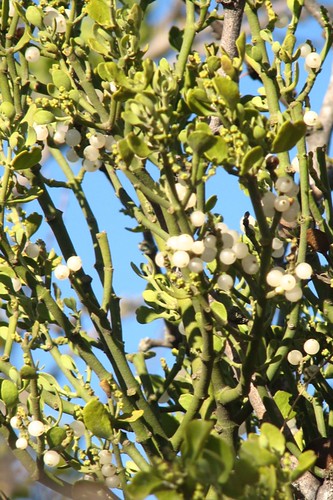
Mistletoe (Viscum album) is synonymous with holiday traditions, particularly its role in the ritual of kissing beneath its boughs. This fascinating plant is a hemiparasite, meaning it attaches itself to trees and shrubs, drawing water and nutrients while still being able to photosynthesize. Mistletoe thrives in winter, producing clusters of small, white berries that are both charming and toxic when ingested by humans. These berries are, however, a vital food source for birds, who help propagate the plant by spreading its seeds.
In gardens, mistletoe can be a beautiful, if somewhat tricky, addition. It prefers to grow in the branches of hardwood trees, such as apple or oak, making careful selection of host plants essential. While mistletoe is often considered a natural invader, its unique growth habit can add interest and a touch of romance to landscapes as long as gardeners are mindful of its parasitic nature.
Mistletoe symbolizes love and friendship, drawn from ancient customs that suggested it held healing properties and blessings. By including this iconic plant in your December garden, you tap into its rich cultural legacy, enriching your garden with not just beauty, but also meaning—a perfect gift for those who seek to weave personal stories into their outdoor spaces during this festive season.
Winter Daphne
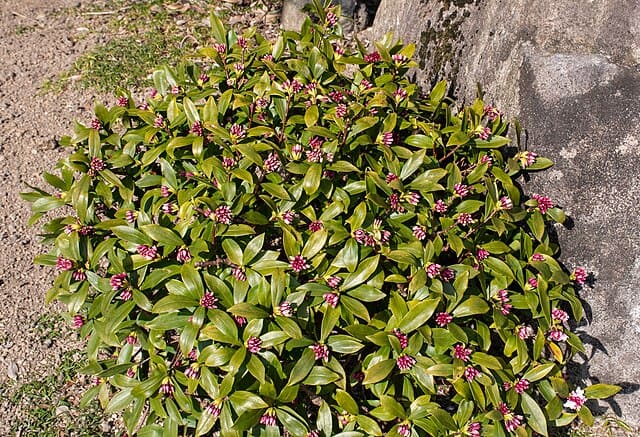
Winter Daphne (Daphne odora) is a fragrant evergreen shrub that thrives in cooler climates, making it a splendid choice for December gardens. This plant exhibits clusters of small, star-shaped flowers in shades of pink and white that bloom from late winter to early spring, but its alluring scent often begins to emerge as early as December. The intoxicating fragrance of Winter Daphne is highly prized, making it an enjoyable addition to any landscape designed for multi-sensory experiences.
Loving well-drained, humus-rich soil, Winter Daphne achieves its best growth in partial shade to full sun. This adaptability helps it thrive in a variety of garden styles, from formal landscapes to more relaxed, cottage-style borders. Additionally, its glossy green leaves provide year-round visual interest, remaining attractive even during the bleakest months.
Symbolically, Winter Daphne is often associated with devotion and romance, enhancing its appeal as a thoughtful gift in winter gardens. The intoxicating scent invites one to linger, creating a serene haven amidst the hustle and bustle of the holiday season. Integrating Winter Daphne into your December landscape marries aesthetic allure with the sensory delight of fragrance, fostering a peaceful atmosphere that invites relaxation and reflection.
Winter Heath
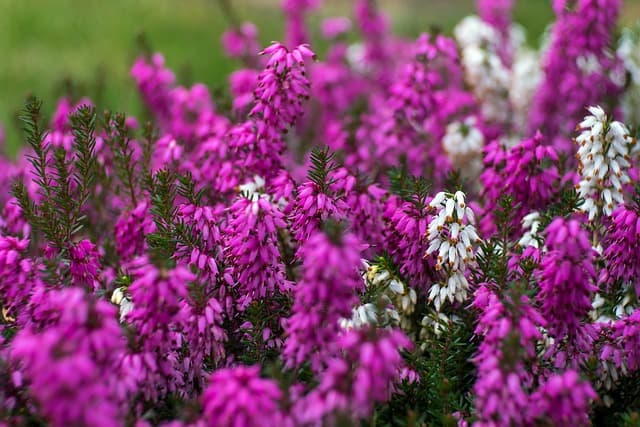
Winter Heath (Erica carnea) is an enchanting evergreen shrub known for its resilient blooming nature during the frosty months. Spreading its delicate, bell-shaped flowers across the landscape, this plant ushers in beauty with hues ranging from deep pink to lilac and white, starting as early as late November and continuing through December. Frequently found trailing gracefully over stones or filling in ground covers, Winter Heath adds a lush texture to gardens, particularly where other plants may falter.
Preferring a well-drained, acidic soil, Winter Heath thrives in full sun to partial shade, making it an ideal candidate for rock gardens, borders, or as a charming highlight in mixed beds. Its ability to attract pollinators like bees and butterflies even in the cooler months underscores its ecological significance, emphasizing the importance of planting for biodiversity—even in winter.
Steeped in symbolism, Winter Heath is often associated with good luck and protection. Including this hardy perennial in your December landscape not only invigorates your garden visually but also weaves a thread of cultural significance into your winter gardening experiences. Its resilience reflects the promise of new life amid the seasonal dormancy, offering gardeners a hopeful reminder that beauty can thrive even in the coldest of times.
Winter’s Rose Camellia
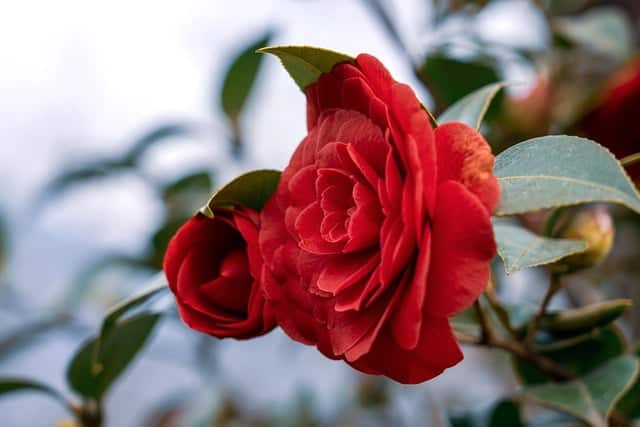
The Winter’s Rose Camellia (Camellia japonica), a stunning evergreen shrub, transforms December gardens into a cascade of luxurious blooms. Known for its rich, rose-like flowers, this camellia variety delights with a wide spectrum of colors, including deep reds, soft pinks, and pristine whites that often appear in abundance during the winter months. The trend of camellia cultivation has gained popularity, particularly in milder climates, where its blooms can last well into spring.
Winter’s Rose Camellia thrives best in partially shaded areas, thriving in slightly acidic, well-drained soils. Its glossy foliage provides an appealing backdrop that enhances the beauty of its flowering clusters. Unlike many other flowering plants, these camellias can bloom even under a light snowfall, making them particularly remarkable during the colder months. Their sturdy blossoms ooze elegance and are often used in winter floral arrangements, elevating both indoor and outdoor settings.
Esteemed for their timeless beauty, camellias have long been symbols of love and admiration. Cultivating Winter’s Rose Camellia in your December landscape allows you to enjoy their splendid blooms, while encouraging feelings of warmth and affection during a season that celebrates togetherness. This exquisite shrub stands as a testament to the enduring power of natural beauty, showcasing the elegance that persists even in the face of winter’s chill.
Winter Jasmine
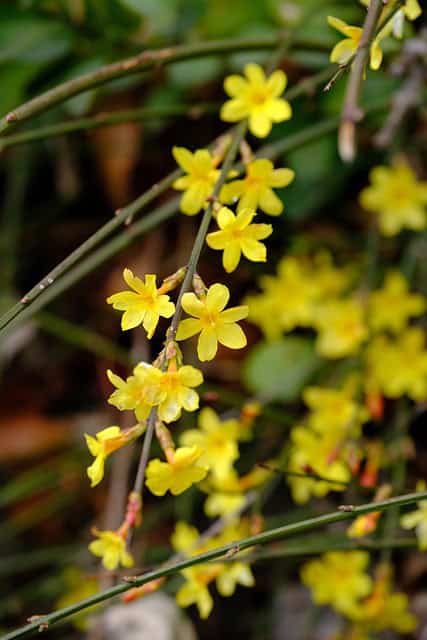
Winter Jasmine (Jasminum nudiflorum) is a delightful deciduous shrub that brightens the winter landscape with its bright yellow blooms. Unlike traditional jasmine varieties known for their heady fragrance, Winter Jasmine captivates with its cheerful, trumpet-shaped flowers that blossom along trailing branches. Starting in late winter, often as early as December, the flowers enliven gardens when many other plants remain dormant.
This resilient plant thrives in a variety of conditions, preferring well-drained soil and full sun to partial shade. It can be trained as a ground cover or a climber, making it a versatile choice for many garden styles. Not only does Winter Jasmine provide vibrant color, but its ability to attract pollinators like bees further enhances its ecological value during a time when nectar sources are scarce.
Symbolically, jasmine is often associated with love and beauty. By introducing this hardy plant into your December garden, you add not just charm and splashes of color but also the sentiments of connection and warmth that accompany the season. Winter Jasmine serves as an uplifting reminder that vibrant life persists even amid winter’s grasp, encouraging the spirit of resilience and renewal in the garden.
Witch Hazel
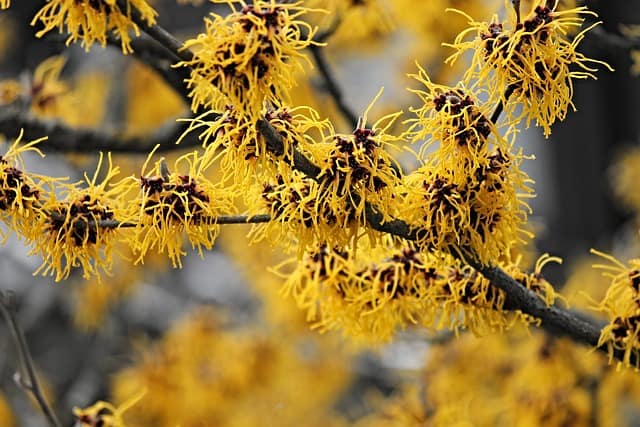
Witch Hazel (Hamamelis intermedia) is a remarkable shrub that surprises gardeners with its striking, bold yellow or orange flowers that bloom in the depths of winter. Emerging from bare branches, these unique flowers appear like wisps of bright color against a typically gray winter sky, often fragrant and attracting early pollinators. This hardy plant typically starts to bloom in December and continues into February, creating visual interest during a time when many other shrubs are dormant.
Witch Hazel thrives in well-drained, loamy soils and prefers partial to full sun, making it a versatile addition to any garden landscape. It is popular not only for its enchanting flowers but also for its attractive, crooked branches that provide structure and form throughout the year. Beyond ornamental appeal, the bark and leaves of Witch Hazel are harvested for their medicinal properties. Traditionally used in herbal remedies, witch hazel extract is well-known for its soothing qualities, especially in skincare.
Integrating Witch Hazel into your December garden not only introduces unique beauty but also evokes a sense of magic and wonder. In folklore, Witch Hazel is associated with protection and purification, enhancing your garden’s ambiance while promoting a deeper connection to nature’s cycles during the winter months.
Growing Indoor Flowers in December
Growing indoor flowers in December is a popular practice that allows garden enthusiasts to enjoy the beauty of blooms year-round. With limited options outside, cultivating plants indoors offers the perfect solution to bring life and color into our homes, especially during the winter months when natural light is minimal. From rich colors to fragrant petals, a variety of indoor flowering plants can create a nurturing and invigorating atmosphere.
African Violets
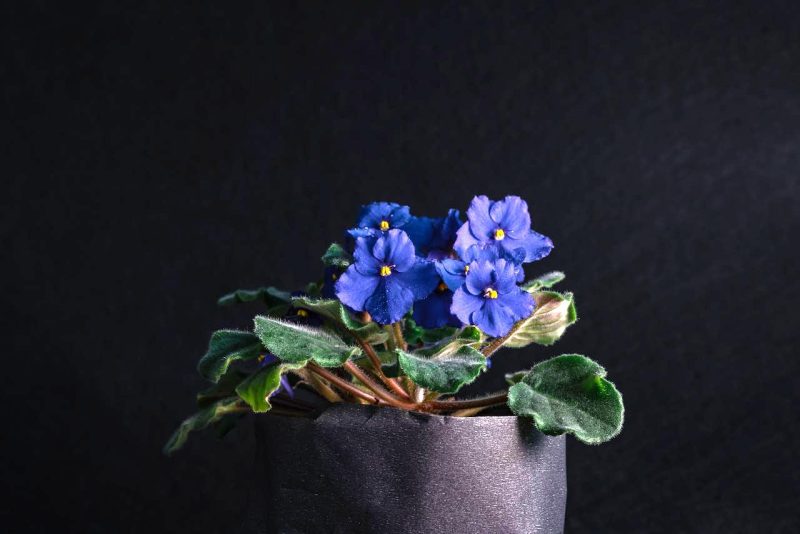
African Violets (Saintpaulia) are a beloved choice for indoor horticulture, particularly during the winter months. These charming flowering houseplants are renowned for their soft, fuzzy leaves and delicate blooms, which come in a variety of shades, including purples, pinks, and whites. African Violets are remarkably adaptable, thriving indoors and lending themselves to various potting arrangements, from single specimens to vibrant groupings.
One of the most appealing aspects of African Violets is their ability to bloom consistently in the absence of natural light. With balanced watering, they can flourish under fluorescent or LED lights, making them well-suited for the shorter days of December. Careful attention to watering is crucial; African Violets prefer to dry out slightly between waterings, and bottom watering is often recommended to prevent crown rot.
Symbolically, African Violets represent love and loyalty, making them a meaningful gift during the holiday season. Additionally, their relatively easy care makes them a popular choice for beginners and seasoned plant enthusiasts alike who wish to infuse their home with a touch of greenery and beauty in the winter months. By cultivating African Violets, you not only add vibrant color to your indoor environment but also connect to a rich history of plant cultivation that has enchanted gardeners for generations.
Amaryllis
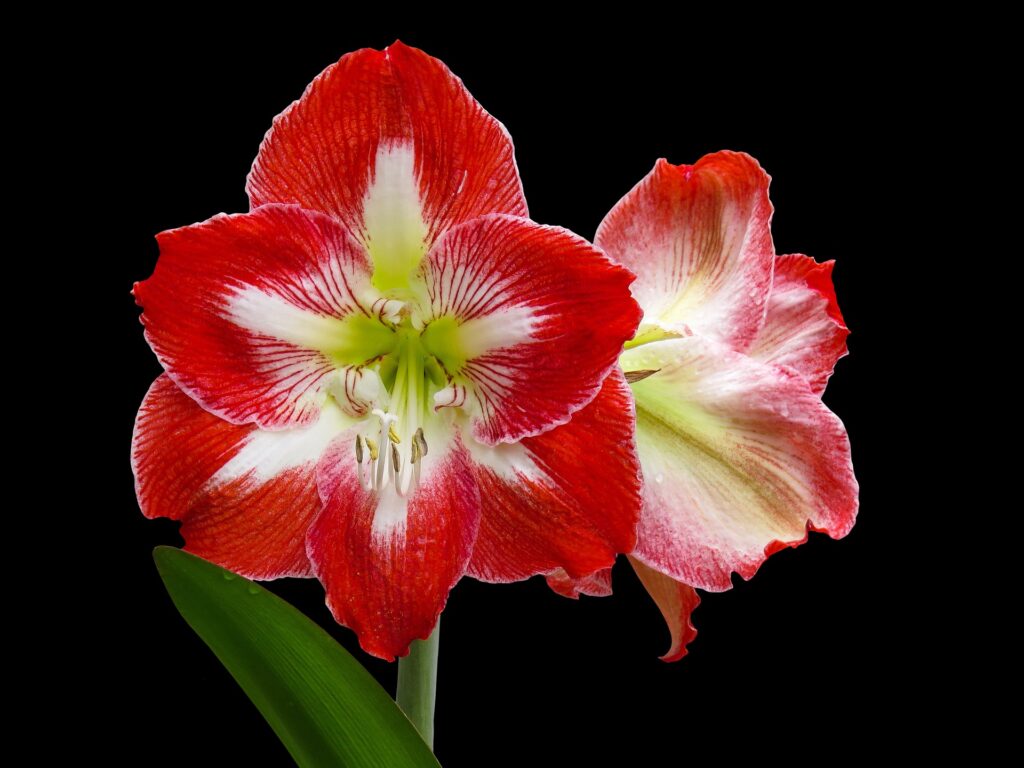
The Amaryllis (Hippeastrum) is a striking bulbous plant that captures the essence of the season with its stunning, large blooms that can reach up to six inches in diameter. Typically appearing in December, the Amaryllis is celebrated for its vibrant colors, ranging from rich reds and pinks to whites and even bicolors. This is a favorite for holiday decorations, as its spectacular flowers serve as a centerpiece or enchanting addition to festive displays.
Growing Amaryllis is a rewarding experience. The bulbs are usually planted indoors, requiring minimal care and only a few essentials: good potting soil, a container with drainage, and adequate sunlight. After planting, it takes about six to eight weeks for the bulbs to produce their first blooms, making them a fantastic choice for those who wish to experience the wonder of gardening even in the winter.
An extraordinary aspect of Amaryllis is its ability to reignite itself. After the initial blooms have faded, the bulbs can be stored for the next season, with some gardeners even claiming that repotted bulbs can produce blooms for several years. This feature not only promotes sustainability but also engages home gardeners in a seasonal ritual of nurturing and care, connecting them with the ebb and flow of life within their own homes.
Anthuriums
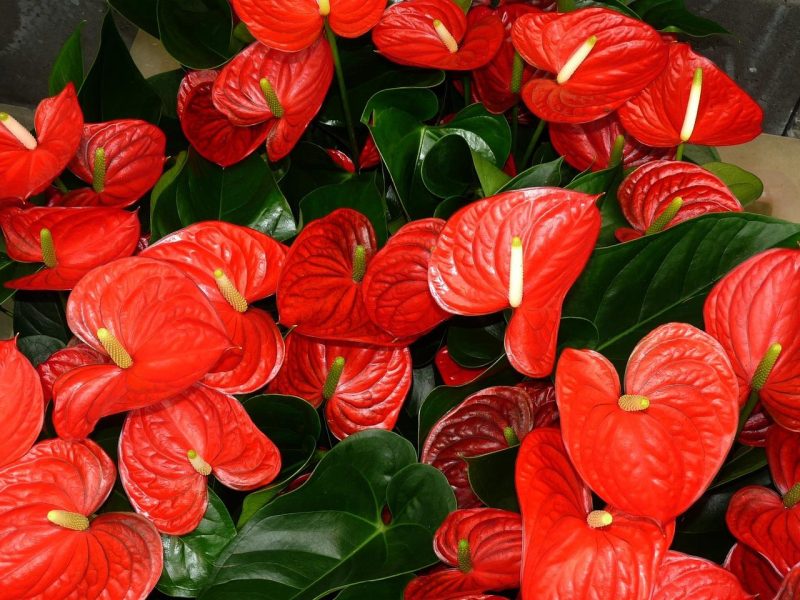
Anthuriums, often referred to as flamingo flowers or laceleaf, are distinguished by their striking, heart-shaped spathes that can be seen in vibrant shades of red, pink, and white. Their glossy appearance and distinctive flowers make them a popular choice during December, adding a tropical flair to winter décor. Known for their long-lasting blooms, Anthuriums not only bring bold aesthetics into indoor spaces but also require relatively low maintenance, making them accessible for everyone.
These plants thrive in bright, indirect light with a preference for high humidity, which makes them particularly well-suited for bathrooms or kitchens. Regular watering is essential, but care should be taken to avoid root rot, as Anthuriums are sensitive to overwatering. Using a well-draining potting mix will help maintain appropriate soil moisture levels.
Symbolically, Anthuriums represent hospitality, abundance, and happiness, qualities that resonate well during the holiday season of gathering and celebration. Their presence can uplift both personal spaces and festive gatherings, embodying the spirit of joy and warmth that comes with this special time of year. Additionally, growing Anthuriums indoors can significantly aid in improving air quality, making them not only beautiful but also beneficial for health and well-being.
Christmas Cactus
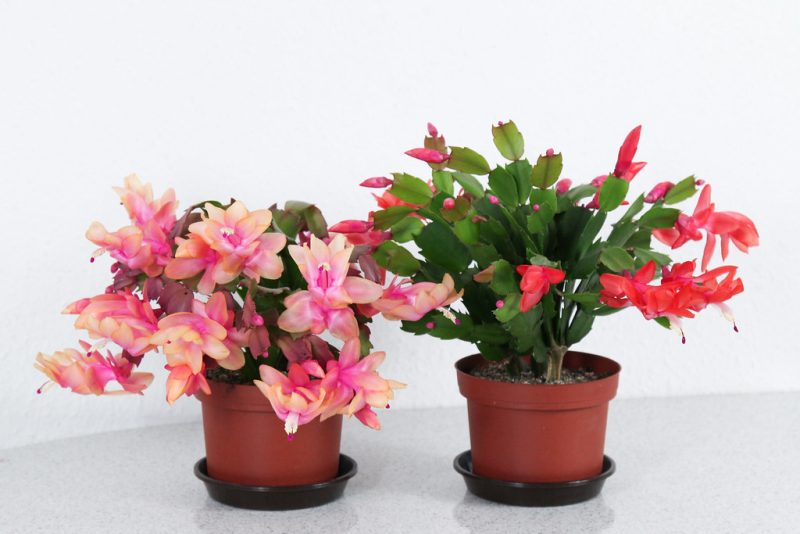
The Christmas Cactus (Schlumbergera) brings a delightful aspect of seasonal cheer, known for its unique and vibrant blooms that often appear during the holiday season. Characterized by its segmented, leaf-like pads and cascading blooms, this plant features flowers in shades of red, pink, and white that can last for several weeks, bringing color into homes throughout December and beyond.
Unlike many traditional cacti, the Christmas Cactus prefers a more humid environment. It thrives best when kept in bright, indirect light and requires regular watering, especially when in bloom—an aspect that is often surprising to new owners who might expect it to be a low-water plant. To encourage blooming, it’s essential to mimic the conditions of the plant’s native habitats, which may include cooler temperatures and a slightly dry resting period after flowering.
Culturally, the Christmas Cactus is rich in symbolism, representing warmth, nostalgia, and connection, making it an ideal gift during the holiday season. Many families cherish this plant as a holiday tradition, with some passing down cuttings from the original plant through generations. The act of nurturing a Christmas Cactus can strengthen familial bonds and provide a sense of continuity even in the busy hustle of winter festivities.
Moth Orchids
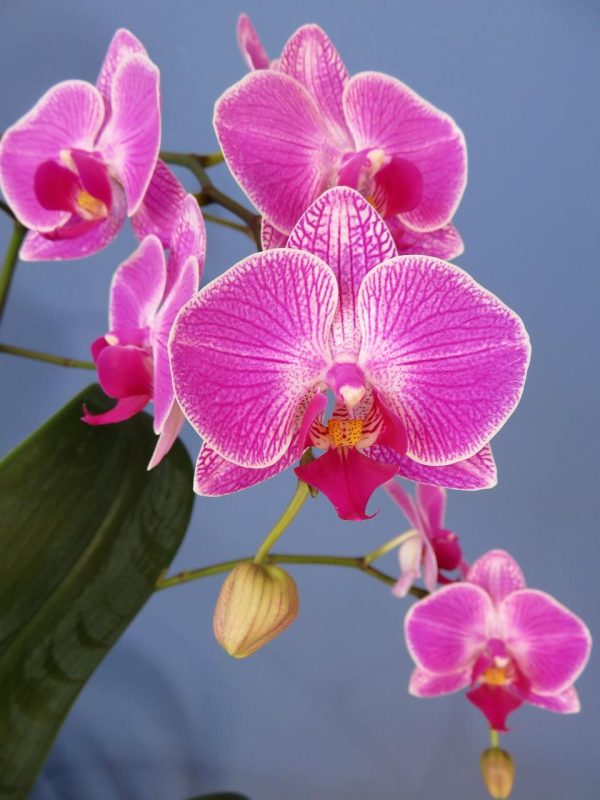
Moth Orchids, also known as Phalaenopsis, are one of the most popular orchid varieties, especially during December. Recognized for their graceful, long-lasting blooms, these orchids can flower for several months, adding elegance and sophistication to any indoor environment. The flowers typically appear in shades of white, pink, or purple, and their delicate, moth-like shape is where they get their name—making them an exotic addition to winter decorations.
Growing Moth Orchids indoors requires some special attention, particularly when it comes to their care. These tropical plants thrive in indirect light, preferring to be placed near a bright window without direct sunlight. Additionally, they enjoy humidity, so using a humidity tray or misting them can work wonders. Watering should be moderate; allowing the potting medium to dry slightly between waterings can prevent root rot and help maintain their health.
The symbolic meaning of orchids often revolves around beauty, strength, and luxury. By incorporating Moth Orchids into your home during December, you create an atmosphere of festivity and elegance. Additionally, their long-lasting flowers serve as a source of joy, blooming at a time when many gardens are bare, bringing the magnificence of the tropics into your winter living space.
Paperwhites

Paperwhites (Narcissus tazetta), a type of daffodil, are a favorite among indoor gardeners during December for their enchanting, fragrant white blooms. These easy-to-grow bulbs are often forced indoors to brighten homes in the winter, producing lovely clusters of white flowers that emerge from slender green stems. Their delicate, sweet scent adds an extra layer of warmth and cheer, making them perfectly suited for holiday décor.
One of the most appealing aspects of Paperwhites is their simplicity in cultivation. They can be grown in water or soil, making them ideal for both novice and seasoned gardeners. When planting, place the bulbs in shallow containers, ensuring the tops remain exposed, and provide adequate water or a well-draining potting mix. They prefer bright, indirect light and can thrive in cooler rooms, making them perfect for winter arrangements.
Culturally, Paperwhites symbolize hope and renewal, pertinent themes during the season of giving and reflection. They embody the anticipation of spring blooms, reminding us that even in the coldest months, new beginnings are just around the corner. By incorporating Paperwhites into your home, you welcome the promise of growth and beauty that will eventually emerge as the seasons change; they serve as a gentle reminder of nature’s resilience.
Peace Lilies
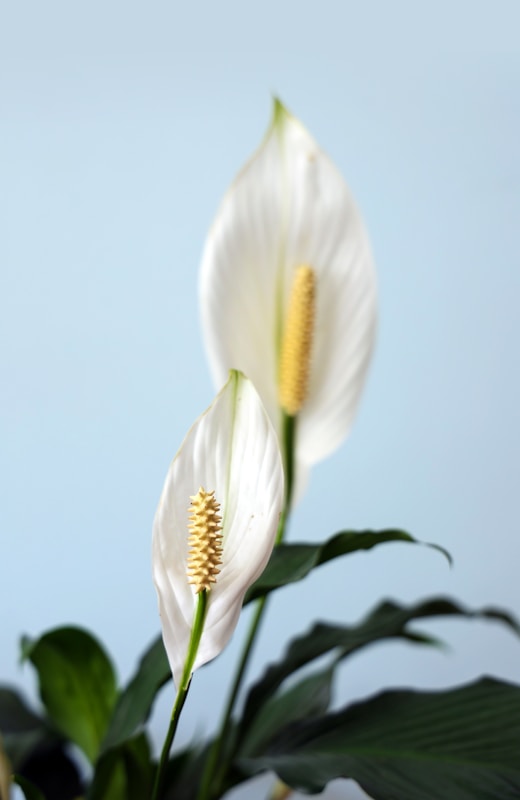
Peace Lilies (Spathiphyllum) are celebrated indoor plants that bloom during the winter months, making them a popular choice throughout December. Renowned for their elegant white flowers and glossy green foliage, Peace Lilies are more than just beautiful—they are also incredibly easy to care for, which has contributed to their widespread popularity in homes and offices alike. Their striking white spathes resemble delicate sails, making them a charming accent for any space.
In terms of care, Peace Lilies thrive in low to medium indirect light, which makes them perfect for dimly lit areas. They appreciate consistently moist soil, but care should be taken to avoid waterlogging, as they are susceptible to root rot. One of their remarkable features is their ability to signal when they need water; drooping leaves are a clear indication that it’s time for a drink. This unique characteristic makes them appealing to beginners and busy individuals who may forget about regular watering.
Beyond their aesthetic appeal, Peace Lilies are known for their air-purifying qualities. NASA’s Clean Air Study recognized them for their ability to filter indoor pollutants, adding a practical benefit to their presence in homes. Symbolically, Peace Lilies represent tranquility, purity, and true prosperity, making them a fitting gift during the holiday season—a gesture suggesting harmony and peace in the coming year.
Poinsettias
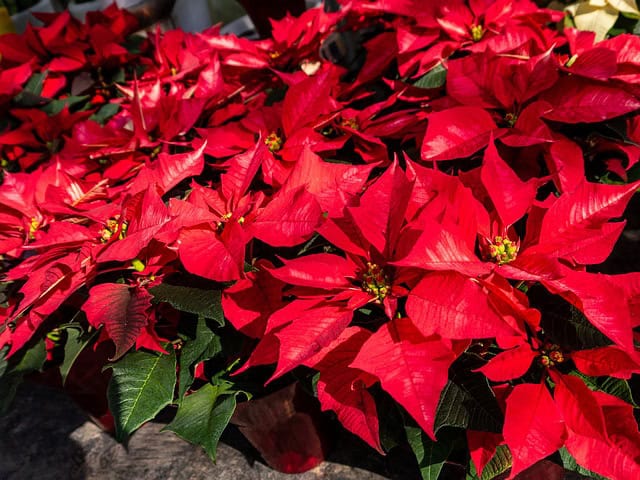
Poinsettias (Euphorbia pulcherrima) are perhaps the most iconic flowers associated with December and the holiday season. With their bright red and green foliage, Poinsettias instantly evoke the spirit of Christmas, making them a staple in homes, churches, and public decorations. Originally from Mexico, these plants can bloom for several months, lasting well into the New Year when cared for properly.
Caring for Poinsettias requires some special considerations. They thrive in bright, indirect light but must be protected from direct sunlight, which can scorch their leaves. Consistent watering is key, with the soil kept slightly moist but not soggy; overwatering can lead to leaf drop. Another unique characteristic of Poinsettias is their sensitivity to temperature; they prefer steady temperatures above 60°F (15°C) and should be kept away from cold drafts and extreme heat.
Poinsettias hold significant cultural importance. Legend has it that they were considered a symbol of the Star of Bethlehem, with their star-shaped blooms commemorating the Christmas story. In Mexico, Poinsettias are also known as “Nochebuena,” or “Holy Night,” linking them directly to the celebration of Christmas. By integrating Poinsettias into your holiday décor, you are not only welcoming a burst of seasonal color into your space but also honoring a tradition steeped in history and meaning.


